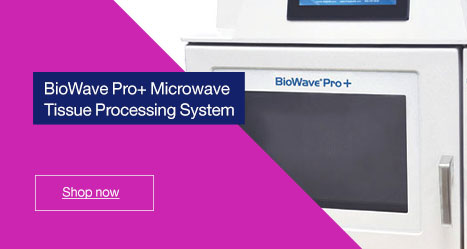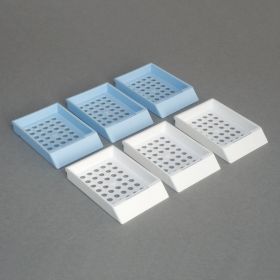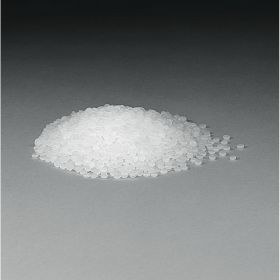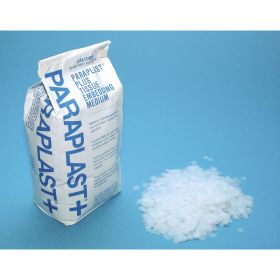Between the fixation of tissue and the embedding in paraffin blocks, tissue is ‘processed’. You can’t embed fixed tissue directly into paraffin wax, so what exactly is tissue processing and what happens in all of the stages? Read on!
After fixation, tissue is transferred to a tissue cassette (http://www.agarscientific.com/lm/tissue-material-processing/processing-cassettes.html).
These usually come in various sizes to accommodate the tissue which you have harvested and fixed. They basically hold and protect the tissue whilst it undergoes the many stages of processing. The end panel of the cassette can be written on (with a pencil- you don’t want to use pen!), or if you are lucky enough to have a well-equipped (and funded!) histology lab, you may have access to a cassette labelling machine. Following processing, the cassette lid is snapped off and the cassette forms a base for the paraffin wax block.
The three mains steps of tissue processing are ‘dehydration’, ‘clearing’ and ‘infiltration’. During each of these stages, the previous solution is dispersed and the tissue in infused with the immersing solution. The main aim of tissue processing is to remove the water from the tissue and eventually replace this with a medium which allows sections to be cut from the block (usually paraffin wax).
Nowadays, most histology labs will be equipped with a dedicated tissue processing machine. Some of the older processers (named ‘dip and dunk’ machines!) have a revolving carousel in which a cage holds all of the tissue cassettes to be processed. Around the carousel are a number of containers of solvents and solutions. The cage is vertically agitated in each solution (for a set period of time) before the carousel lifts it up and dunks it in the next solution. During the whole process (usually run overnight) the tissue goes through many stages of dehydration and clearing ready for paraffin wax embedding.
These ‘dip and dunk’ machines are falling out of favour nowadays- especially in histopathology labs. Samples may become contaminated by cells, tissue residues etc left over in each of the solutions which could potentially lead to false-positive pathology results. However, for routine lab and research work, the carousel machines are still fairly common.
The more modern design of tissue processors have a chamber containing the tissue cassettes. Fresh dehydration and clearing solutions are pumped in and out of the chamber. These fluid-transfer (or ‘enclosed’) machines often incorporate vacuum or pressure cycles as well as raised temperatures- all of which enhance tissue processing and reduce the time taken from fixation to embedding.
Dehydration
The first stage of processing is that of dehydration. Any water which is present in the tissue (either bound or free) needs to be removed for effective embedding. Paraffin wax is naturally hydrophobic and consequently for effective wax infiltration, the sample must be dehydrated. The tissue is immersed in a series of increasing concentrations of ethanol until a 100% water-free solution is reached. The series of increasing solutions ensures that not only is all of the water gradually removed and replaced with ethanol, but also avoids the excessive distortion of the samples.
This process is not without some tissue damage though. Many cellular components are removed or dissolved in the increasing ethanol concentrations including water-soluble proteins and even some lipids.
Clearing
At the end of the dehydration steps, the tissue should be completely water-free in 100 % ethanol. However, it’s not ready for embedding just yet- ethanol and paraffin will simply not mix.
This intermediate stage is called ‘clearing’- the aim of which is to remove the ethanol and replace with a solution which is miscible with the paraffin wax. The term ‘clearing’ actually refers to the high refractive index of the solvents and when samples are immersed in it, they become transparent and clear.
The most common solvent used for clearing is xylene. After the dehydration stages, the tissue is immersed in one to three separate xylene solutions. During these immersions, the ethanol is gradually replaced with xylene. Then when the tissue is embedded (or ‘infiltrated’) the xylene is replaced by molten paraffin wax.
Xylene will remove any fat residue left within the samples and this can sometimes cause shrinkage of the tissue.
Infiltration
The final stage of tissue processing is called ‘infiltration. This is when the xylene from the clearing steps is replaced with molten paraffin wax which infiltrates the tissue (you can buy paraffin wax direct from Agar Scientific here: http://www.agarscientific.com/lm/tissue-embedding/paraffin-wax.html ). The tissue samples are usually immersed in three separate paraffin waxes to ensure that none of the xylene is left within the samples. Following the final wax infiltration stage, the tissue cassettes are transferred to a tissue embedding centre/station. This piece of histology equipment has reservoirs containing molten wax, hotplates to keep the tissue and wax in solution whilst it is moved to the desired position within the wax mould and a cold plate for setting of the wax blocks. This stage is sometimes referred to as ‘blocking out’. The blocks are taken from the last stage of infiltration and placed in a reservoir of molten wax. Using heated forceps, the tissue is placed into a suitably sized mould (also containing molten wax), the cassette is placed on top and then the whole assembly topped up with more molten wax from a separate reservoir within the embedding station. The mould, cassette and tissue are then transferred to the cold plate of the station to set.
If you would like a superior paraffin embedding medium, then have a look at Paraplast Plus (http://www.agarscientific.com/lm/tissue-embedding/paraplast-174-plus.html ). Not only is this double filtered for extra purity and clarity of wax, but also contains a small percentage of DMSO which penetrates tissue three-times faster than standard paraffin wax. It also contains plastic polymers which help when cutting short ribbons of sections to 1µm, and excellent ribbon continuity with a 2µm thickness.
The main (typical) stages in tissue processing;
| Process | Solution | Time |
| Dehydration | 70% ethanol | 60 mins |
| Dehydration | 90% ethanol | 45 mins |
| Dehydration | Absolute ethanol | 45 mins |
| Dehydration | Absolute ethanol | 45 mins |
| Dehydration | Absolute ethanol | 60 mins |
| Clearing | Xylene | 60 mins |
| Clearing | Xylene | 60 mins |
| Clearing | Xylene | 60 mins |
| Infiltration | Paraffin Wax | 30 mins |
| Infiltration | Paraffin Wax | 60 mins |
| Infiltration | Paraffin Wax | 90 mins |
| Blocking Out | Paraffin Wax | n/a |
Author: Martin Wilson





